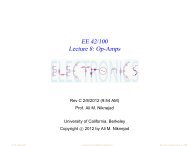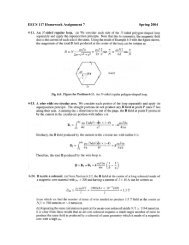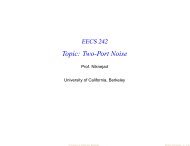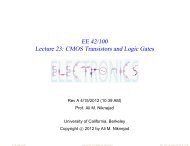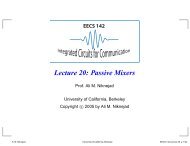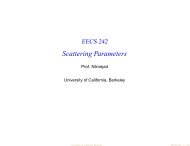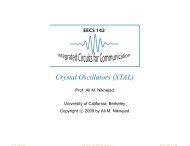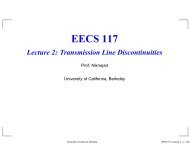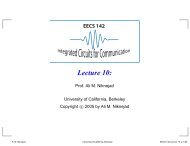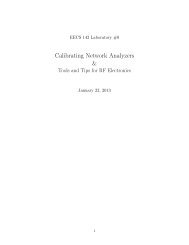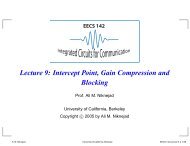Siliconization Of 60 GHz - Ali M. Niknejad
Siliconization Of 60 GHz - Ali M. Niknejad
Siliconization Of 60 GHz - Ali M. Niknejad
Create successful ePaper yourself
Turn your PDF publications into a flip-book with our unique Google optimized e-Paper software.
peripherals such as external hard drives and monitors.<br />
The case of the mobile smart phone is particularly<br />
important since the existing wireless connectivity is<br />
either too slow and power hungry (Bluetooth) or designed<br />
and optimized for longer ranges (WiFi). What<br />
is missing is a wireless universal connectivity that<br />
can support high data rates demanded by large data<br />
rate multimedia applications. Wireless technology has<br />
been conspicuously absent from MP3 music players<br />
(such as Apple’s iPod), which are ideal candidates for<br />
downloading music and video. While ultrawideband<br />
(UWB) technology using the 3–10 <strong>GHz</strong> band promised<br />
to fulfi ll these needs, it fell short in many ways, and,<br />
today, most of the start-up companies pursuing UWB<br />
have folded.<br />
Now many are making the same promises about<br />
<strong>60</strong>-<strong>GHz</strong> technology, so it is interesting to briefly<br />
explore the similarities and differences among these<br />
technologies. The UWB spectrum offered 7 <strong>GHz</strong> of<br />
bandwidth in the United States, but, when you consider<br />
a global UWB solution, the bandwidth is smaller<br />
(6–10 <strong>GHz</strong>) due to regulatory restrictions. More importantly,<br />
the allowed power transmission in this band is<br />
severely restricted by the Part 15 spectrum emission<br />
mask (24.3 dBm/MHz). By contrast, the maximum<br />
transmission power in the <strong>60</strong>-<strong>GHz</strong> band is orders of<br />
magnitude higher. In the United States, up to 39 dBm<br />
equivalent isotropically radiated power (EIRP) can<br />
be transmitted (due to the oxygen absorption in this<br />
band). Most UWB standards channelized the band<br />
into 500-MHz chunks, which limits the power even<br />
further, whereas most <strong>60</strong>-<strong>GHz</strong> standards use channels<br />
with over 1.5 <strong>GHz</strong> bandwidth. These differences translate<br />
into much higher capacity and much longer range<br />
communication in the <strong>60</strong>-<strong>GHz</strong> band compared to the<br />
UWB band. This is true even after the differences in<br />
propagation loss are taken into account. In fact, for<br />
the same aperture, a much higher gain antenna can<br />
be realized at <strong>60</strong> <strong>GHz</strong> compared to, say, 5 <strong>GHz</strong> due to<br />
the shorter wavelength. There are also clear disadvantages<br />
to operation at <strong>60</strong> <strong>GHz</strong> arising from the line-ofsight<br />
(LOS) nature of the channel. Interestingly, there<br />
are some similarities between UWB and <strong>60</strong> <strong>GHz</strong> in<br />
that both require a sophisticated baseband processor<br />
to handle the long delay spread relative to the symbol<br />
duration, which requires equalization or orthogonal<br />
frequency-division modulation (OFDM). Moreover,<br />
the wideband modulation requires a very fast analogto-digital<br />
converter (over 1 <strong>GHz</strong>), which can be a big<br />
source of power consumption if a high dynamic range<br />
signal is digitized directly. Techniques to lower the<br />
dynamic range of the baseband signal using mixedsignal<br />
techniques can benefit both kinds of systems.<br />
Applications of <strong>60</strong> <strong>GHz</strong><br />
Figure 1 shows many scenarios where a high-speed<br />
Gb/s link can enhance the modern user’s experience.<br />
Point-to-Point Link<br />
100 m – 1 m<br />
100 Mb/s – 1 Gb/s<br />
Last Mile<br />
Broadband<br />
High-Speed<br />
Wireless<br />
LAN<br />
100 Mb/s M<br />
–1Gb/ –1Gb/s<br />
802.15.3 mmWIG<br />
Wireless Home<br />
Video and<br />
Data Link<br />
Figure 1. Potential applications for a high data rate<br />
<strong>60</strong>-<strong>GHz</strong> link.<br />
For example, the wireless LAN network today is limited<br />
to about 100 Mb/s, while the wired Ethernet cables<br />
are operating today at 1 Gb/s and will move to higher<br />
speeds in the near future. Many homes are converting<br />
to an optical connection which will offer high bandwidths<br />
to homes and offices, and users will demand a<br />
similar performance boost in their networks.<br />
One of the most exciting applications for UWB<br />
technology was a wireless USB-like connection. The<br />
ubiquity and simplicity of USB has transformed the<br />
computer industry. Users today buy peripherals and<br />
connect them to their PCs without having to worry<br />
about making the right connection. This is an example<br />
of a great success story in the PC industry. If we can<br />
similarly deliver a wireless USB-like connection with<br />
<strong>60</strong> <strong>GHz</strong>, the flexibility and ease of use will enhance<br />
the experience even further. Once users become accustomed<br />
to an untethered USB experience, there will be<br />
no turning back to cables.<br />
While existing applications will benefit from the<br />
higher speeds offered by <strong>60</strong> <strong>GHz</strong>, there are many<br />
emerging applications that will fundamentally change<br />
the way we use technology. Consider the hypothetical<br />
<strong>60</strong>-<strong>GHz</strong>-enabled iPhone, shown in Figure 2, which<br />
could use the <strong>60</strong>-<strong>GHz</strong> connection to download movies<br />
from a kiosk (perhaps at a train station or airport),<br />
transmit video to a larger screen for easier viewing<br />
(wireless docking), and connect to external peripherals<br />
such as hard disks and wired and optical networks.<br />
If such a device is realized with reasonable power consumption,<br />
we see that it can truly displace the laptop<br />
computer for most users.<br />
Now that analog TV has been discontinued in the<br />
United States, many users are upgrading their television<br />
sets to flat panel high-definition television<br />
(HDTV) screens. While the enhanced resolution and<br />
picture quality of digital TV is an exciting step forward,<br />
we have also taken a step backward by introducing<br />
February 2010 79


